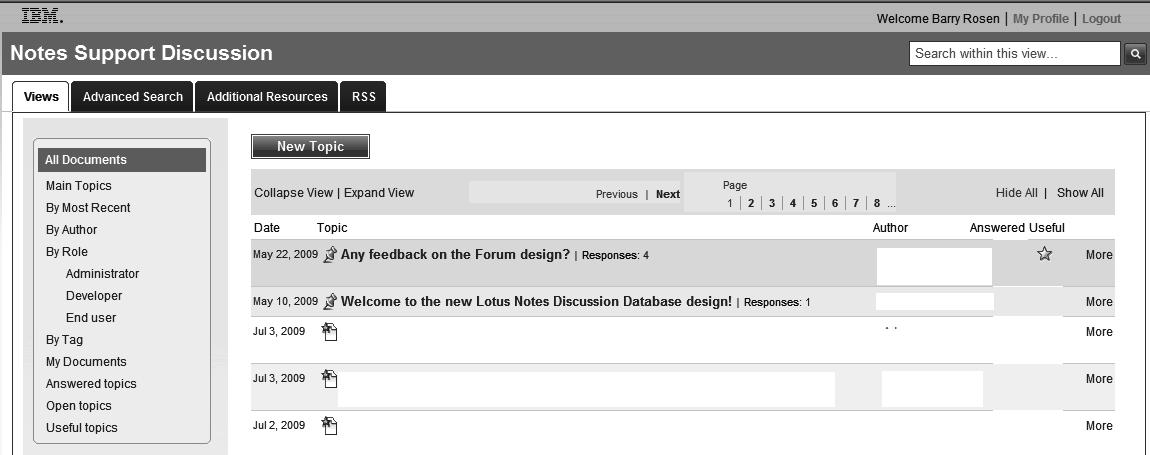There are many exciting changes and additions to Domino Designer 8.5. We will begin with the introduction of the Eclipse based integrated development environment. Domino Designer 8.5, which is also known as Domino Designer on Eclipse or DDE, takes advantage of Eclipse technology to deliver a more powerful developer environment. The look and feel is more consistent with Notes client version 8.x. The new UI will be examined at a high level. The next major feature addition that will be covered is XPages. XPages are a new type of design element being introduced in the 8.5 release that will revolutionize Domino Web Applications. XPages enable application developers to quickly and easily create rich Domino web applications with a Web 2.0 look and feel. Finally, we will review improvements to CSS support, enhancements to HTML generation, JavaScript controls, a new method related to ID Vault: ResetUserPassword, and changes to web services.
Domino Designer on Eclipse
Now in 8.5 the Domino Designer client is based on Eclipse, as the Notes client was in 8.x. Eclipse is an award-winning, open source platform for the construction of powerful software development tools and rich desktop applications. This architectural change allows the new designer client to become an open source pluggable environment. By allowing the use of plugins, objects can be built, re-used, and shared.
Some of the differences in the new 8.5 Designer client can be seen when examining the processes associated with Domino Designer. It is useful to know how they relate to one another and what component each controls. Prior to release 8.5 designer clients, when you launched designer.exe, nlnotes.exe would be spawned. This is the process in which pre-8.5 Domino Designer ran.
Now in the 8.5 Designer client, designer.exe loads and spawns nlnotes.exe.
On faster machines, designer.exe shows up briefly, and may not be seen at all.
Then the notes2.exe process spawns and designer.exe quits.
notes2.exe is the Java process that corresponds to the Eclipse shell.
Finally, nlnotes.exe spawns ntaskldr.exe after DDE opens.
Some other things you may notice are that launch and exit take longer than in previous versions. This is due to the Eclipse startup and shutdown sequences. This can lead to problems on exit or launch. If you experience a problem with launch or exit, it may be due to one of the following issues. Due to the longer exit time, the user may have initiated launch before all prior processes had been killed, or the user may have initiated the launch sequence multiple times. It is also possible that, on prior exit, the client did not shut down all processes.
With a few exceptions, the launch process will be able to compensate for these errors. However, if you still can't launch or exit the 8.5 designer client, you can try the following, manually. Kill the nlnotes.exe and notes2.exe processes with the task manager, or if the client still will not launch or exit, log off the system to completely kill all process threads.
The new Eclipse-based GUI
Now that the 8.5 Designer client is Eclipse based, there is a new UI. The default perspective in 8.5 is the Domino Designer perspective. There are other perspectives available in Domino Designer 8.5, each suited to a particular task. You can select a different perspective from the menu, select Window | Open Perspective | Other, as seen in the following screenshot:
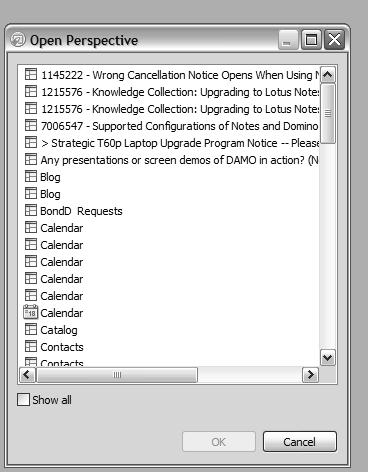
Not all perspectives have a corresponding layout in the UI.
Perspectives can be customized to suit individual preferences. One way is by resizing the views and editors.
You can resize views and editors in one of two ways. Click the Maximize/Restore button located in the title bar of the view or editor. Or, click and drag the border of a view or editor.
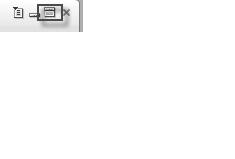
Views and editors can also be hidden by clicking the view Close button.

Unlock access to the largest independent learning library in Tech for FREE!
Get unlimited access to 7500+ expert-authored eBooks and video courses covering every tech area you can think of.
Renews at $19.99/month. Cancel anytime
Use the menu pick Window | Show Eclipse Views to reopen closed views. You can use this menu pick to open any Eclipse view, including those from other perspectives.
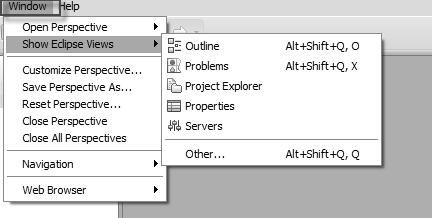
To return to the current perspective's default layout use the menu pick Window | Reset Perspective....
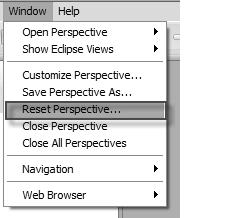
XPages
For a while now it has been difficult to create elegant web applications for Notes/Domino. XPages are a new type of design element being introduced in the 8.5 release, that will allow application developers to quickly and easily create rich Domino web applications with a Web 2.0 look and feel.
Applications built using XPages are supported for web use only, for the 8.5 release. To enhance the appearance and functionality for web use, existing applications can be extended to utilize XPages. The standard design elements must be included in the database for use in the Notes client and the application. If a new application is targeted for both Notes client and web users, then you can also include XPages for use on the Web.
XPages are built on top of JSF, or Java Server Faces, technology. XPages also have built-in Ajax support, which allows application developers to take advantage of Ajax features such as type-ahead and partial page refresh. They are created in pure XML markup. When the application developer adds controls to XPages using drag and drop, the XML is generated automatically.
XPages does not require any additional steps to install on a Domino server. When you create a new XPage in an application, you start with a blank page similar to what you see when a new form or page is created. You then build the XPage by dragging and dropping controls onto the XPage to add functionality. A wide array of controls is available out of the box, which enables application developers to quickly and easily get a web application up and running. Some examples of the controls available are a pager, rich text editor, date picker, tabbed panel, and many more. Controls can also be combined into a single object, called a custom control. Custom controls are similar to sub-forms, as they can be used in other XPages in the current application or copied into other applications for reuse. Just like with sub-forms, if a change is made to a custom control in an application, that change is propagated out to all other instances of that custom control in that application.
There is a default system template in the 8.5 release that uses XPages. The discussion template has been enhanced to include XPages in 8.5.
Improvements to CSS Support
Now in Domino Designer 8.5 you can edit and create CSS. Previously, you would have to use an external editor to do this. Not only can you create custom stylesheets, but you can import existing ones. You can also group your favorite stylesheets and script resources into a theme to provide a common look and feel in your application and map style classes to UI controls. This will save developer time and effort when adding CSS to applications. To create a new stylesheet:
Click File | New | Style Sheet Resource from the main Eclipse menu. In the New Style Sheet dialog box, do the following:
In the Name field, type the name of the stylesheet.
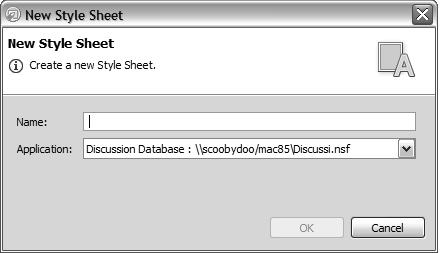
By default, Domino Designer adds a CSS file extension to this name
In the Application field, select an application for the stylesheet. Click OK
Another method of creating a stylesheet, is by double-clicking Resources | Style Sheets in the Applications navigator and then clicking New Style Sheet in the editor.
 United States
United States
 Great Britain
Great Britain
 India
India
 Germany
Germany
 France
France
 Canada
Canada
 Russia
Russia
 Spain
Spain
 Brazil
Brazil
 Australia
Australia
 Singapore
Singapore
 Canary Islands
Canary Islands
 Hungary
Hungary
 Ukraine
Ukraine
 Luxembourg
Luxembourg
 Estonia
Estonia
 Lithuania
Lithuania
 South Korea
South Korea
 Turkey
Turkey
 Switzerland
Switzerland
 Colombia
Colombia
 Taiwan
Taiwan
 Chile
Chile
 Norway
Norway
 Ecuador
Ecuador
 Indonesia
Indonesia
 New Zealand
New Zealand
 Cyprus
Cyprus
 Denmark
Denmark
 Finland
Finland
 Poland
Poland
 Malta
Malta
 Czechia
Czechia
 Austria
Austria
 Sweden
Sweden
 Italy
Italy
 Egypt
Egypt
 Belgium
Belgium
 Portugal
Portugal
 Slovenia
Slovenia
 Ireland
Ireland
 Romania
Romania
 Greece
Greece
 Argentina
Argentina
 Netherlands
Netherlands
 Bulgaria
Bulgaria
 Latvia
Latvia
 South Africa
South Africa
 Malaysia
Malaysia
 Japan
Japan
 Slovakia
Slovakia
 Philippines
Philippines
 Mexico
Mexico
 Thailand
Thailand






